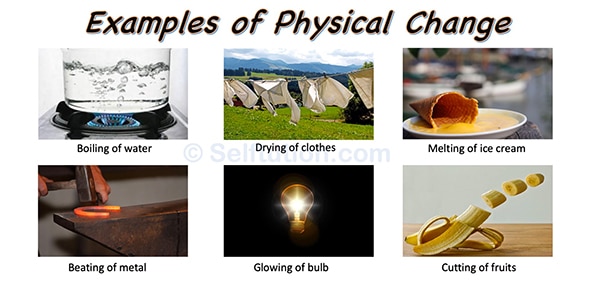

Nitroglycerin is very dangerous because it explodes easily neon poses almost no hazard because it is very unreactive. Iron, for example, combines with oxygen in the presence of water to form rust chromium does not oxidize. Examples of chemical properties include flammability, toxicity, acidity, reactivity (many types), and heat of combustion. The change of one type of matter into another type (or the inability to change) is a chemical property. In each of these examples, there is a change in the physical state, form, or properties of the substance, but no change in its chemical composition. Other examples of physical changes include magnetizing and demagnetizing metals (as is done with common anti-theft security tags) and grinding solids into powders. We observe a physical change when, for example, wax melts, sugar dissolves in coffee, and steam condenses into liquid water. Other physical properties, such as the melting temperature of iron or the freezing temperature of the water, can only be observed as matter undergoes a physical change.Ī physical change is a change in the state or properties of matter without any accompanying change in its chemical composition (the identities of the substances contained in the matter). We can observe some physical properties, such as density and color, without changing the physical state of the matter observed. Familiar examples of physical properties include density, color, hardness, melting and boiling points, and electrical conductivity. Physical Properties of MatterĪ physical property is a characteristic of matter that is not associated with a change in its chemical composition. The characteristics that enable us to distinguish one substance from another are called properties. For instance, the flammability of gasoline is a chemical property evident from the chemical changes in the composition of gasoline when it burns, turning gasoline into entirely new substances, primarily carbon dioxide and water. Thus, chemical changes produce entirely new forms of matter which differ from the matter present before the change.
#Examples of chemical changes series
The copper undergoes a series of chemical reactions, one of which is shown here, to form a layer of blue-green patina on an otherwise naturally brown penny. Chemical changes involve chemical reactions and are often observed through a change in color or odor.įor example, when a copper penny is exposed to air and water there is a chemical change.

In order to identify a chemical property, we look for a chemical change. Corrosiveness, flammability, toxicity, acidity, or chemical reactivity are all examples of chemical properties of matter. Thus, physical changes only alter the state of the matter or physical conditions, without changing the chemical composition.Ĭrushing, grinding, slicing, blending, magnetizing, or demagnetizing are other common ways to change the physical condition of matter.Ĭhemical properties of matter, on the other hand, are characteristics that can only be measured and observed when the substance has a change in chemical composition. Similarly, when liquid water freezes to solid ice, the chemical composition of both the water and ice remains the same. However, this liquid is still composed of gold atoms, so this is a physical change. But when it is melted at a high temperature, it changes its state from a solid to a liquid. For example, pure gold in its solid-state is made up of tightly packed gold atoms. Other physical properties can only be observed when matter undergoes physical changes. Similarly, the smell of gasoline is also a physical property.

So, when we say that helium gas is lighter than air, we are referring to a physical property. Some of these physical properties can be observed without changing the physical state of the matter. Odor, taste, color, appearance, hardness, density, melting and boiling points, and electrical conductivity, are all examples of physical properties. Physical properties of matter can be measured and observed without changing the composition or identity of the matter.

Matter exhibits two types of properties: physical and chemical. Characteristics that help us to distinguish one type of matter from another are referred to as properties.


 0 kommentar(er)
0 kommentar(er)
